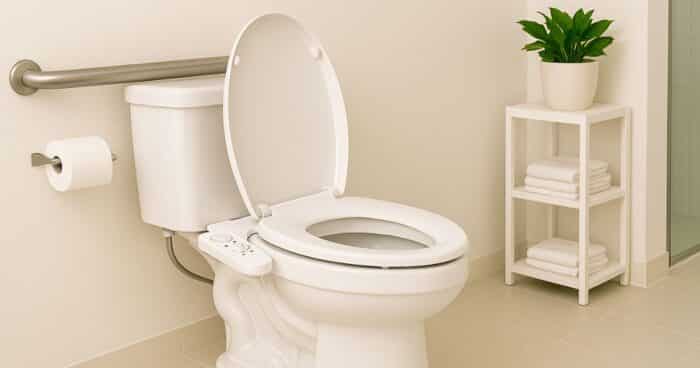
For older adults, using the bathroom can become a daily struggle that affects comfort, hygiene, and quality of life. Limited mobility, reduced dexterity, or balance issues can turn a simple task into a major challenge.
Bidet toilet seats offer a cleaner, safer, and more dignified bathroom experience. These easy-to-use tools can make a big difference for seniors and caregivers alike.

Our Top Bidet Attachment Picks
| LUXE Bidet NEO 110 | – Non-electric – Adjustable water pressure – Rear wash – 18-month warranty |
View on Amazon |
| Bio Bidet BB2000 Bliss Electric Bidet Toilet Seat | – Warm water – Heated seat – Night light – Slow-close lid |
View on Amazon |
| Tushy Classic 3.0 | – Non-electric – Self-cleaning sprayer – Adjustable water pressure |
View on Amazon |
*Daily Caring may receive commissions for purchases made through links in this article.
Using the Bathroom Becomes More Challenging with Age
On average, people use the toilet seven times a day. It’s one of the most basic activities of daily living and is a common reason for older adults to start losing independence.
Stiffness, weakness, pain, frailty, balance issues, and cognitive issues like Alzheimer’s or dementia can make going to the bathroom difficult or dangerous. A bidet is a simple product that can help seniors be more independent in the bathroom.
What is a Bidet?
Bidets are a hands-free way to wash the perineal area, usually after a bowel movement. A wand under the toilet bowl sprays a small stream of clean water to cleanse the area. They’re more common in Europe and Asia, but are gaining popularity in the U.S.
With a bidet, your loved one won’t have to bend and twist to wipe their behind. The bidet will do the clean-up; they’ll just need to pat the area dry. Bidets are hygienic and great for gentle, delicate skin.
Tips for Caregivers
Bringing up bathroom-related changes can be awkward. Frame the conversations about a bidet as a way to maintain dignity and reduce the need for hands-on help. Show your loved one how it works, and consider practicing together at first.
A bidet can also reduce the number of full-body cleanups needed after an accident, saving time and reducing stress for caregivers and loved ones.
How Much Does a Bidet Cost and How Do You Install It?
The bidets we’re talking about aren’t the expensive freestanding ones. Many bidet attachments for toilets are made to fit standard toilets and are in the $40 price range.
These bidets can be easily attached (and detached) and don’t require special plumbing. They use the same clean water feed that goes into the toilet tank.
If you want to get a little fancier, there are bidets with warm water spray, but those are more expensive and often require electricity or a separate hookup to the sink’s hot water supply.
This 3-minute video shows exactly how to install one of these bidets on a standard toilet.
Benefits of Bidets for Seniors
When older adults start losing the strength, flexibility, and balance needed to use the toilet safely, each trip can become a dangerous and exhausting challenge. This could lead to poor personal hygiene, potential urinary tract infections, or falls.
With 90% of U.S. seniors wanting to remain in their own homes as they age, it’s important to find ways to help them be more independent while increasing their safety.
Bidets help by:
- Improving hygiene by removing the struggle of wiping
- Reducing urinary tract infection (UTI) risk through improved hygiene
- Protecting delicate skin – no more wiping with paper
- Reducing fall risk – no more bending or twisting to clean up, saves strength for safe sitting and standing
- Making seniors more willing to go to the bathroom because it’s no longer a chore
For less independent older adults or those with incontinence, a bidet makes it much easier for you to keep those essential parts clean without having to convince them to take a shower or bath.
Who Should Not Use a Bidet
While bidets can help many older adults, they may not be a good fit for everyone. People with advanced cognitive deficits like late-stage dementia may be confused by the controls or misuse the spray.
If a loved one has open wounds, recently had surgery, or deals with certain skin conditions, they should consult their doctor before using one. Adjusting the spray pressure to avoid discomfort with sensitive skin or hemorrhoids is also essential.
Bidet Safety Considerations
Many modern bidets include safety features that are especially helpful for older adults. Look for models with:
- Adjustable water pressure to prevent discomfort
- Temperature control or cold-only spray to avoid burns
- Simple controls with dials or buttons that are easy to operate for people with arthritis or low vision
To improve overall bathroom safety for older adults, focus on reducing fall risks and making daily tasks easier. Install grab bars near the toilet and in the shower, use a non-slip bath mat, and consider a raised toilet seat if standing is difficult.
Adequate lighting, especially at night, is key, and a night light or motion-activated toilet light can prevent accidents.
A sturdy shower chair and a handheld showerhead can make bathing safer and more comfortable.
Sturdy seating and a clutter-free bathroom can also help reduce the risk of falls.
Two Common Bidet Options
Standard Bidet Attachment
This $40 Luxe Bidet model is highly rated on Amazon by over 10,000 people and easily attaches to a standard toilet.
Raised toilet seat
Some older adults use a raised toilet seat to make it easier to sit down and stand up. However, most bidets made to attach to standard toilets aren’t recommended for use with raised toilet seats.
Bio Bidet is a company that makes a bidet that works with their raised toilet seat. It’s $500, so it’s quite expensive, but much less than the cost of a private caregiver or assisted living facility. It would be worth it if it allows your loved one to be more independent and live at home longer.
You might also consider calling bidet companies with less expensive standard models to see if they have any that would work with a raised toilet seat, or they could suggest ways to make it work.
Maintenance and Cleaning
Keeping a bidet clean is important for hygiene and longevity. Most models can be wiped down with mild soap and water weekly. Some have self-cleaning nozzles, which reduce maintenance. Avoid harsh cleaners that might damage the plastic parts.
Check the manufacturer’s instructions for specific care and cleaning guidelines.
Bidet Alternatives
If a full bidet setup isn’t practical, there are other toileting aids that can help:
- Perineal cleansing wipes: Unscented, hypoallergenic wipes designed for sensitive skin
- Portable bidets: Handheld spray bottles or battery-operated devices that can be used at home or while traveling
These can be useful in caregiving situations or for people uncomfortable with a toilet-mounted bidet.
Final Thoughts
A bidet toilet seat is a minor upgrade that can make a big difference for seniors with limited mobility or caregivers trying to manage hygiene. A bidet might be a worthwhile solution if you’re looking for comfort, safety, or more independence in the bathroom.
Frequently Asked Questions
Do bidets require electricity to work?
Basic bidet attachments do not require electricity—they connect directly to your toilet’s water supply. More advanced models with warm water, air dryers, a heated seat, or other features may need an electrical outlet nearby.
Are bidets safe for seniors with sensitive skin or hemorrhoids?
Yes, most bidets allow you to adjust the water pressure for a gentler spray, which can be more comfortable than wiping with toilet paper. Still, it’s a good idea to talk to a doctor if your loved one has hemorrhoids, skin irritation, or is recovering from surgery.
Can you use a bidet with a raised toilet seat?
Most standard bidet attachments aren’t compatible with raised toilet seats. However, some companies, like Bio Bidet, make models that work with their own raised seat systems. It’s best to check with the manufacturer for options or recommendations.
You might also like:
— 4 Simple Bathroom Safety Tips for Seniors
— Home Safety for Seniors: 10 Quick Fixes for Bathroom, Bedroom, and Kitchen
— Is It Alzheimer’s or a Urinary Tract Infection?


Connie Chow
Connie was a hands-on caregiver for her grandmother for 20 years. (Grandma made it to 101 years old!) She knows how challenging, overwhelming, and all-consuming caring for an older adult can be. She also knows how important support is — especially in the form of practical solutions, valuable resources, and self-care tips.






